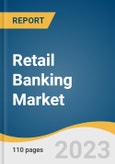The global retail banking market size is expected to reach USD 2,840.70 billion by 2030, growing at a CAGR of 5.6% from 2023 to 2030. The growth is attributed to the increasing focus of banks on improving the customer experience through offering competitive interest rates and improved customer connectivity. By providing better rates and strengthening customer interactions, banks aim to attract and retain customers, leading to increased market demand for their services.
In addition, the stable nature of retail deposits in a demand-driven economy contributes to the growth of the market. Retail banks typically rely on customer deposits as a stable and reliable source of funding. As customers trust the stability of retail banking institutions, they are more likely to deposit their funds, providing banks with a solid foundation for lending and other banking activities. This stability allows retail banks to operate with lower marketing efforts and focus on meeting the evolving expectations of customers for various products and services.
Another factor is the ongoing modification of business processes by retail banking companies to reduce operational costs. By streamlining operations and optimizing efficiency, banks can lower their expenses and potentially pass on cost savings to customers in the form of more competitive rates and fees. This cost-reduction strategy enhances the attractiveness of their products and services, driving the growth of the retail banking industry.
The COVID-19 pandemic highlighted the importance of remote banking services, pushing banks to improve their digital infrastructure and customer experience. As a result, customers who may have been hesitant to embrace digital banking before the pandemic became more comfortable and experienced the benefits of convenience, speed, and accessibility. This shift in customer behavior and the growing acceptance of digital banking services are expected to have a lasting positive impact on the growth trajectory of the retail banking industry.
In addition, the stable nature of retail deposits in a demand-driven economy contributes to the growth of the market. Retail banks typically rely on customer deposits as a stable and reliable source of funding. As customers trust the stability of retail banking institutions, they are more likely to deposit their funds, providing banks with a solid foundation for lending and other banking activities. This stability allows retail banks to operate with lower marketing efforts and focus on meeting the evolving expectations of customers for various products and services.
Another factor is the ongoing modification of business processes by retail banking companies to reduce operational costs. By streamlining operations and optimizing efficiency, banks can lower their expenses and potentially pass on cost savings to customers in the form of more competitive rates and fees. This cost-reduction strategy enhances the attractiveness of their products and services, driving the growth of the retail banking industry.
The COVID-19 pandemic highlighted the importance of remote banking services, pushing banks to improve their digital infrastructure and customer experience. As a result, customers who may have been hesitant to embrace digital banking before the pandemic became more comfortable and experienced the benefits of convenience, speed, and accessibility. This shift in customer behavior and the growing acceptance of digital banking services are expected to have a lasting positive impact on the growth trajectory of the retail banking industry.
Retail Banking Market Report Highlights
- The private sector banks segment dominated the market. The private sector banks have invested significantly in technology and digital transformation. They have embraced advancements such as online and mobile banking, chatbots, and seamless digital payment solutions, contributing to the segment’s growth
- The debit and credit cards segment is expected to experience rapid growth due to the rise of e-commerce and online shopping. Cards are the preferred payment method for online transactions, providing a seamless and secure payment experience
- The Middle East & Africa region is expected to experience rapid growth. Digital transformation is playing a pivotal role in the growth of the retail banking industry in the MEA region. The widespread adoption of smartphones and increasing internet penetration have created a conducive environment for digital banking services
Table of Contents
Chapter 1. Methodology and Scope
Chapter 2. Executive Summary
Chapter 3. Market Variables, Trends, and Scope
Chapter 4. Retail Banking Market: Type Estimates & Trend Analysis
Chapter 5. Retail Banking Market: Service Estimates & Trend Analysis
Chapter 6. Retail Banking Market: Regional Estimates & Trend Analysis
Chapter 7. Competitive Landscape
List of Tables
List of Figures
Companies Mentioned
- BNP Paribas
- Citigroup, Inc.
- HSBC Group
- ICBC
- JP Morgan Chase & Co.
- Bank of America Corporation
- Barclays
- China Construction Bank
- Deutsche Bank AG
- Mitsubishi UFJ Financial Group, Inc.
- Wells Fargo
Methodology

LOADING...
Table Information
| Report Attribute | Details |
|---|---|
| No. of Pages | 110 |
| Published | May 2023 |
| Forecast Period | 2022 - 2030 |
| Estimated Market Value ( USD | $ 1840.77 Billion |
| Forecasted Market Value ( USD | $ 2840.7 Billion |
| Compound Annual Growth Rate | 5.6% |
| Regions Covered | Global |
| No. of Companies Mentioned | 11 |









